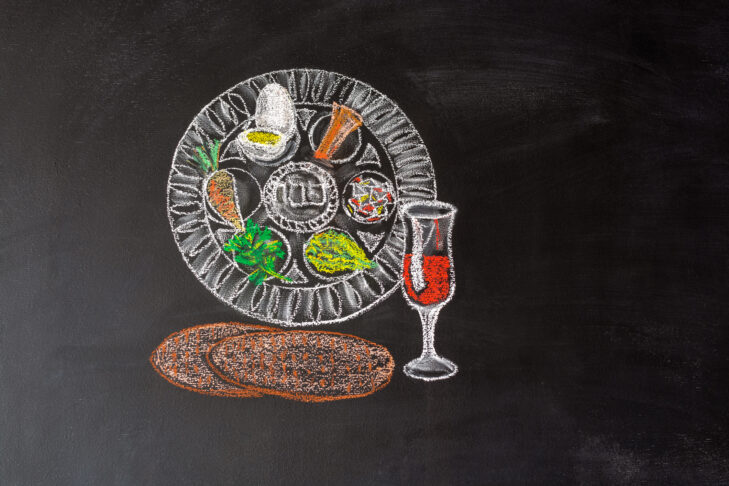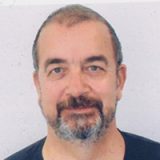Each year at Passover, we are tasked to remember that we were once slaves, to relive that slavery and reflect on the freedom of Exodus. We make thousands of years ago as real as today, to go from mitzrayim, “the narrow place,” toward freedom. We reflect on bondage and the need for freedom, acknowledging that we are still on the journey to that freedom in our personal lives and in the world.
This past year our world has certainly been “a narrow place.” We’ve experienced pandemic, shutdown and quarantine, illness, death, demonstrations and rancor. Our Passover last spring was difficult and distanced—for many, as broken as the afikomen we break to hide at the seder.
Will this year’s seder be like the last? Zoomed, empty chairs, distances far and near, filled with a still uneasy anticipation of what might come—and mourning dear ones permanently absent? It has been a hard year for so many of us. Yet we turn again to this ritual that marks spring, new beginnings and the hope of freedom. Yes, we will celebrate Passover, no matter where or how.
Here are some art-filled ideas (some with a nod to issues of the past year) to help make your seder a little different and meaningful.
Food
Why not try something new this year? Let’s acknowledge the fact that the whole world has shared in this pandemic, and that Jews come in many colors and cuisines across the globe; let’s reach beyond the regular menu. Our friends at OneTable assembled a wonderful short cookbook with recipes from around the world that we’ve been waiting to try.
For karpas: We remember the bitterness of slavery by partaking of the karpas—the bitter herbs dipped in salt water. Add a new part to this blessing with these words from American Jewish World Service.
More karpas, please: Don’t skip the parsley and salt water, but here’s something else to keep hungry stomachs at bay until the real meal begins: spring quinoa with pesto and greens from The Nosher.
Make freedom and social justice a central point of the seder
The past year brought the issues of social justice, race and immigration to the public consciousness in profound ways. Jews of color became an important flash point in our community. Perhaps this year we can commit ourselves to working to ensure that the freedom we seek is only possible when everyone has an equal seat at the table—including the seder table.
Rabbi Sandra Lawson, a Black rabbi, wrote about her experiences in this piece for The Forward, and offered this prayer song on Twitter:
My kavanah – intention for a silent Amidah this morning
Ella’s Song
We who believe in freedom cannot rest
We who believe in freedom cannot rest until it comes
Until the killing of black men, black mothers’ sons
Is as important as the killing of white men, white mothers’ sons. pic.twitter.com/MdxmggM2wm— Rabbi Sandra Lawson (@rabbisandra) June 8, 2020
Add poetry
“Why Is This Night Different?” by Ray Shakman
Why is this night different
now that we are older
and our children are with us
each one of us crosses the same desert
helping the stragglers
lifting the forlorn and lost
helping life into life
helplessness into healing hope
we are here together
hearing each story as if it were our own
committed to keeping the story alive
the journey going.
A couple of years ago, JArts sponsored poetry on the MBTA for National Poetry Month. A poem by Yehuda Amichai was mounted on subways and streetcars throughout the area as our contribution to the month. Amichai is perhaps the most famous of Israeli poets. Here’s a poem from the Poetry Foundation that fits in with the need for peace this, and each, Passover:
“Wildpeace” by Yehuda Amichai
Not the peace of a cease-fire,
not even the vision of the wolf and the lamb,
but rather
as in the heart when the excitement is over
and you can talk only about a great weariness.
I know that I know how to kill,
that makes me an adult.
And my son plays with a toy gun that knows
how to open and close its eyes and say Mama.
A peace
without the big noise of beating swords into ploughshares,
without words, without
the thud of the heavy rubber stamp: let it be
light, floating, like lazy white foam.
A little rest for the wounds—
who speaks of healing?
(And the howl of the orphans is passed from one generation
to the next, as in a relay race:
the baton never falls.)
Let it come
like wildflowers,
suddenly, because the field
must have it: wildpeace.
(From “Selected Poetry.” Copyright © 1996 by Yehuda Amichai. Reprinted by permission of University of California Press.)
Add another question
Only four questions? Ridiculous. The whole seder is meant to beg as many questions as possible. Here are some you might add:
- What challenges from the past year—from COVID and quarantine—can you transform into something you can learn from and turn into something healing, good and loving?
- Breaking the matzah represents the brokenness in our world and our commitment to repair it. What’s one repair you’ll make this year?
- If you could add a fifth question to the manish tanah—”Why is this night different?”—what would it be?
Add new music and sing
Vocalist Anthony Russell is a Massachusetts-based, globally hailed Jewish singer, most known for singing Yiddish songs. He’s performed for JArts often, including at one of our first JLive broadcasts last spring. Recently, he’s been working to blend Jewish/Yiddish classics and African-American spirituals in a project he calls “CONVERGENCE,” releasing a recording with the acclaimed klezmer band Veretski Pass. The video above is a moving solo version he performed at a synagogue that illustrates this unique artist.
Daniel Kahn is an American-born, Berlin-based singer/musician specializing in Yiddish protest music. He’s participated in several JArts programs, most notably The Semer Project, which we brought to Boston in 2017. Here’s a video of Kahn singing Leonard Cohen’s “Hallelujah”—in Yiddish! (Stay tuned for a coming JArts program this spring that celebrates Leonard Cohen; you won’t want to miss it.)
Add new stories and new ways to tell them
Each year we tell the central story of our slavery and freedom. Add something new this year.
Tell a family story: Is there a story you know from your own family, from past generations, sad or funny, that can add meaning to the seder? Tell it.
Put on a play: Here’s a family that makes masks to act out the story.
Listen to a story: The Haggadah speaks of our being brought out of Egypt by God with “a mighty hand and an outstretched arm.” Here’s a short story about a mighty hand to listen to from a storyteller who deserves listening to—Nate Dimeo. Originally from Providence, he worked in Boston for some time. While he’s not Jewish, he’s married to someone who is and, as you will discover, understands our story quite well. It’s short and called “The Year Hank Greenberg Hit 58 Home Runs.” (Think it’s about baseball? Think again.)
Include visual art
Make visual art a part of your seder. Show some old family pictures, pictures of vacations (you’re on a journey, remember). Show drawings your kids made, maybe during the year, or make new ones to celebrate.
Use a colorful Haggadah—there are so many now. Israeli artist Yaacov Agam has one you can find here.
Israeli artist Zoya Cherkassky made an art world splash with her drawing “Black Chuppah” last summer, based on a wedding ceremony she saw on YouTube held in a Jewish cemetery—based on “plague weddings” held in the 19th century to ward off cholera pandemics. She expanded her works with a show in Los Angeles. We thought her piece “Girl at the Window” summed up the past year so well. Discuss it.
Offer a final prayer
“As our world suffers,
sickened by this virus—we pray.”
Recite “Vaccinate Us” by Rabbi Jen Gubitz of Temple Israel of Boston.
This post has been contributed by a third party. The opinions, facts and any media content are presented solely by the author, and JewishBoston assumes no responsibility for them. Want to add your voice to the conversation? Publish your own post here. MORE



